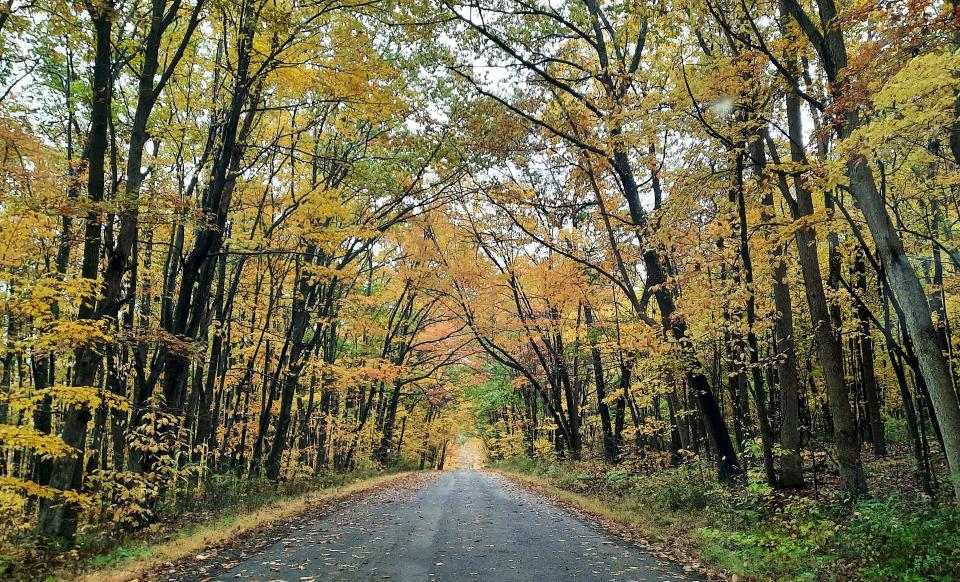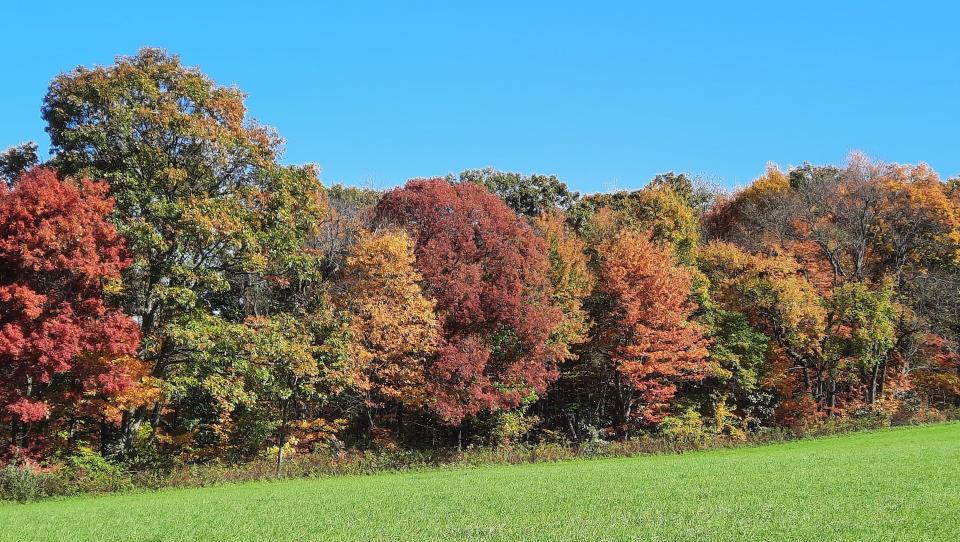We love Pennsylvania's fall foliage. A fungus and higher temps are affecting its timeline.
Leaf experts believe this fall has been better than average for color and have noted leaves are falling earlier in some parts of the state because of a fungus.
The National Weather Service made a chart documenting the Pennsylvania Department of Conservation and Natural Resources’ weekly fall leaf maps comparing the years 2018 through 2023.
The chart shows much of the state in early November 2018 still had either best color or was starting to fade. In 2022, all but the southeastern part of the state was beyond peak that same week. The eastern corner was starting to fade.
While the chart is interesting, two experts hope people don't read much into the six-year comparison.
“There might be some minor deviations at the start of each year, based on how warm it is,” Aaron Tyburksi, meteorologist for the National Weather Service in State College, said in a telephone interview.
Looking at the map, he believes how warm or cold it was each year would contribute to any differences. “The general trend is through the month of October we see that peak leaf color from north to south.”
Looking at long-term data, he said, “The last week of September we start to see those first colors near the New York border. As is typical, we move through the first week of October, that peak leaf colors works its way south,” Tyburski said.

“By the middle of October, we’re starting to see, especially the higher elevations over northcentral Pennsylvania and the Laurel Mountains, they start to see the colors increase as well.”
Toward the end of October the better colors are found in the southeastern part of the state.
Ryan Reed, natural resource program specialist with the Pennsylvania Department of Conservation and Natural Resources, compiles the foliage reports for the agency.
“What I’m seeing is just a timetable, a window that is offset towards the later part of the year,” he said in a telephone interview.
Fall foliage is a six-week affair that Reed doesn’t believe has really changed during the seven years he’s been producing the foliage reports.
In looking at the six-year chart, Reed says you can’t read a lot into it regarding the future. “Six years does not make a trend. Six years is too small of a sample size to deduce anything.”
He said the middle years of the graphic have variations to the start and end years. “The comparison is interesting and would have potential. If we were looking at 60 years of data, OK, I would have something there, maybe even 20 or 30 years, but I don’t really think six years is enough to draw a statistical trend,” he said.
In looking at historical averages involving northeastern states, Reed said “their current averages for peak color and the whole fall foliage window, is occurring roughly two weeks later than historically what you might expect.”
With lower temperatures contributing to the speed that leaves change colors and fall, Reed pointed out, “Our falls have been notably warmer in the last couple of decades.”
“The process that begins the degradation of chlorophyl in the leaves is slowed,” he said. “The primary factor for the decreased production in chlorophyl is day length and that has not changed. But what has changed is the annual fall temperature.”
“The typical fall cooldown that we might expect if we are older people, we’re not seeing that. We’re seeing the typical fall cooldown more delayed and hedging toward November,” he said.
Fungus affects leaf quality
Reed said he believes outbreaks of fungus, like anthracnose, on deciduous trees can affect leaf quality. He said it can turn leaves brown. “Under our climate change scenario, what we are seeing is more incidents of major outbreaks of anthracnose during the fall season.
“Maybe you could make the argument that fall foliage season is shorter in areas that are really affected by the anthracnose and the most pronounced areas in Pennsylvania where that’s noticeable is in the northern tier where we have a greater percentage of northern hardwoods and specifically maples,” he said.
There have been places in northern Potter County, northern Tioga, maybe Bradford, McKean (counties) where there’s almost been no fall foliage season. “For people who travel or live in those areas, that’s very disappointing to see a tiny bit of color and the next thing you know the leaves are all brown and, before you know it, the leaves are on the ground,” Reed said.
“You could make the argument under the climate change scenario, it does narrow the time for fall foliage, perhaps even impacting it to the point where there’s almost nothing, but that certainly hasn’t been widespread."
“The climate change scenario does not bode well for fall foliage season in Pennsylvania," he said. "The reason for that is we see more pest outbreaks in the forests, and then on top of that we generally have conditions for vigorous growth of trees.”

Autumn 2023 at a glance in Pennsylvania
Reed believes this has been one of the better years. “In my seven years, I would say this ranks up there near the top. If this wasn’t the top year, I would say it’s number two or three.
“This year was a fantastic year for fall color. I saw an inordinate amount of awesome fall foliage photos from all over the state,” he said about his trips across the commonwealth.
Regarding the quality of the leaf colors, Tyburski didn’t see anything unusual. “The foliage this year seems to be about average, similar to most other years,” he said. “The colors tended to be what we would expect for this time of year.”
He added, “If you get the opportunity to get out and see them, this is the only chance you get,” Tyburski said about areas that still have foliage, like southern Pennsylvania
Brian Whipkey is the outdoors columnist for USA TODAY Network sites in Pennsylvania. Contact him at bwhipkey@gannett.com and sign up for our weekly Go Outdoors PA newsletter email on this website's homepage under your login name. Follow him on Facebook @whipkeyoutdoors, X @whipkeyoutdoors and Instagram at whipkeyoutdoors.
This article originally appeared on The Daily American: PA fall foliage color pops in 2023, but climate, fungus effects felt

